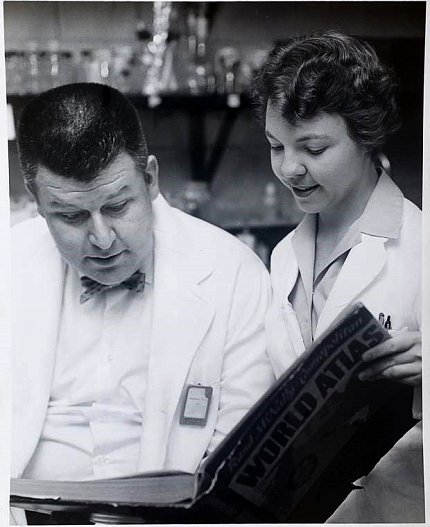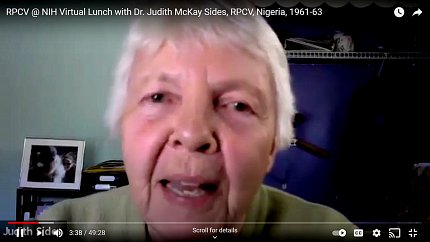60 Years Later
Reconnecting with First NIH’er to Join the Peace Corps

Back in 1961, the NIH Record ran a story about a young researcher who was leaving Bethesda’s leafy campus to join the Peace Corps.
Since then, hundreds of Peace Corps volunteers have come to work at NIH. An affinity group of returned Peace Corps volunteers (RPCVs) at NIH was formed in 2015.
On the occasion of the 60th anniversary of the Peace Corps, they saw the Record article and wondered, “Whatever happened to that young researcher?” They tracked her down and found Dr. Judith McKay Sides happily ensconced in the Appalachian Mountains of western North Carolina, where she readily agreed to join the group’s monthly Zoom call and share some stories.
“I’m 82 years old now and I like to boil things down,” Sides began. “Naturally, researching at NIH and volunteering in Peace Corps were major highlights 60 years ago. It seems like yesterday.”
Her first paid job was at NIH’s National Institute of Arthritis and Metabolic Diseases (now NIDDK).

“I was a GS-5 at $5,000 per year,” she recalled. “I rented a tiny spare bedroom at somebody’s house in Bethesda, slept on a stretcher, ate hard-boiled eggs and drank vegetable soup from cans.”
Sides recalled working as a laboratory assistant to Dr. Frederick Stohlman, “a large, brilliant man,” the editor of Blood magazine, studying erythropoiesis.
“Our source of erythropoietin was Randy, a 10-year-old boy suffering aplastic anemia with very high levels of the hormone in his urine,” Sides recounted. “My job was to condense gallons of Randy’s valuable urine, extract his erythropoietin, and prepare different concentrations to inject into rats. At my first evaluation with Dr. Stohlman, he requested that I stop carrying two big flasks of Randy’s priceless urine at a time and spend less work time reading articles about our experiments. I should do that at home.”
In January 1961, Washington was abuzz about Kennedy’s inauguration. A colleague at NIH had several tickets to be a hat-check girl at 1 of the 5 inaugural balls. Sides remembered the snowy night at the D.C. National Armory.
“We were paid $25 each,” she said. “The armory was packed with 14,000 people. Jackie Kennedy was recovering postoperatively from a Cesarean section, so the presidential couple did not dance. That evening was a blast. I bought snow boots with my $25.”

Sides was in only the third group of Peace Corps volunteers to fly out to their host country. She was assigned to Nigeria, shortly after its independence, where she taught piano and anatomy—using a standing cow skeleton they assembled—at the newly opened University of Nigeria campus in Nsukka.
After her Corps service, she earned a medical degree at Tufts Medical School, where Stohlman was then on the faculty, and later went into practice in Marblehead, Mass.
As Sides reminisced, the Zoom audience was enthralled.
“Here is my essence,” she summarized, “Be friendly, useful, helpful, apolitical, make do and have fun.”
It was a wonderful way to mark the Peace Corps’s 60th anniversary, linking together the first NIH RPCV with the current generation, celebrating the continuous themes of inquiry and service.
See Sides’ article in the Record at https://nihrecord.nih.gov/sites/recordNIH/files/pdf/1961/NIH-Record-1961-08-29.pdf. Returned Peace Corps volunteers at NIH are encouraged to join the affinity group at https://list.nih.gov/cgi-bin/wa.exe?A0=rpcvs_at_nih.
